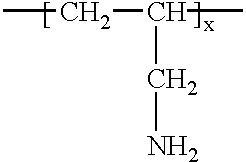Acid functional polymer dispersants
a functional polymer and acid technology, applied in the field of acid functional polymer dispersants, can solve the problems of uneven pigmentation in the product, problems in application, isocyanate crosslinking process,
- Summary
- Abstract
- Description
- Claims
- Application Information
AI Technical Summary
Problems solved by technology
Method used
Image
Examples
example 1
Synthesis of Dispersant from Homopolycaprolactone
40 parts by weight of lauric acid, 456 parts by weight of ε-caprolactone and 0.5 parts by weight of tetrabutyl titanate (TYZOR® TBT from E.I. Dupont de Nemours, Inc.) were charged to a reactor. The reactor was equipped with a mechanical stirrer, a nitrogen inlet tube, a water separator, a thermometer, an addition funnel and a water cooled reflux condenser and an electric heating mantle. The reaction temperature was slowly raised to 180° C. under N2 and held for 10 hours. The polymer produced was a yellow solid at room temperature, with an acid value of 22.2 and 98% by weight non volatiles, tested for 1 hour at 110° C. After the temperature cooled down to 110° C., 21.5 parts by weight of pentaethylenehexamine (Aldrich Chemicals) were added into the reaction mixture, which was then heated to 125° C. with stirring for 6 hours. Subsequently, the reaction mixture was cooled to 70° C. 300 parts by weight of xylene was added to the reaction ...
example 2
Synthesis of Dispersant from Homopoly 12-Hydroxystearic Acid
460 parts by weight of 12-hydroxystearic acid (acid #180 and hydroxy #157), 60 parts by weight of xylene and 0.4 parts by weight of dibutyl tin oxide (Aldrich Chemicals) were charged to a reactor similarly equipped as in Example 1. The reaction temperature was slowly raised to 205° C. under N2 for 7 hours until all of the water generated was removed by azeotropic distillation. The xylene was then removed from the reaction mixture via distillation. The polyester formed was a brown liquid with an acid number of 37. After the reactor was cooled to 110° C., 31 parts by weight of pentaethylenehexamine (Aldrich Chemicals) were added. The reaction was then continued for 6 hours at 125° C. then cooled to 70° C. 300 parts by weight of xylene were then added to reduce the viscosity of the mixture followed by the addition of 31 parts by weight of succinic anhydride. The reactor temperature was then allowed to increase slightly without...
example 3
Synthesis of Dispersant from a Copolymer of Caprolactone and 12-Hydroxystearic Acid
375 parts by weight of 12-hydroxystearic acid (acid #180, hydroxyl #157), 375 parts by weight of ε-caprolactone (Aldrich Chemicals), 1.0 part by weight of dibutyltin oxide (from Aldrich) and 100 parts by weight of xylene were charged to a reactor equipped as in Example 1. The reaction temperature was slowly raised and held at 200° C. for 10.5 hours under N2. The water generated was removed by azeotropic distillation. Then, xylene was removed via distillation. The resulting polymer was a yellow waxy material with an acid number of 17.0. After the reaction mixture was cooled to 110° C., 26 parts by weight of tetraethylenepentamine were added with stirring and the temperature was increased and held at 125° C. for 6 hours. After cooling to 70° C., 500 parts by weight of xylene were added to reduce the viscosity followed by 28 parts by weight of maleic anhydride. The temperature was allowed to increase sli...
PUM
| Property | Measurement | Unit |
|---|---|---|
| temperature | aaaaa | aaaaa |
| temperature | aaaaa | aaaaa |
| temperature | aaaaa | aaaaa |
Abstract
Description
Claims
Application Information
 Login to View More
Login to View More - R&D
- Intellectual Property
- Life Sciences
- Materials
- Tech Scout
- Unparalleled Data Quality
- Higher Quality Content
- 60% Fewer Hallucinations
Browse by: Latest US Patents, China's latest patents, Technical Efficacy Thesaurus, Application Domain, Technology Topic, Popular Technical Reports.
© 2025 PatSnap. All rights reserved.Legal|Privacy policy|Modern Slavery Act Transparency Statement|Sitemap|About US| Contact US: help@patsnap.com



